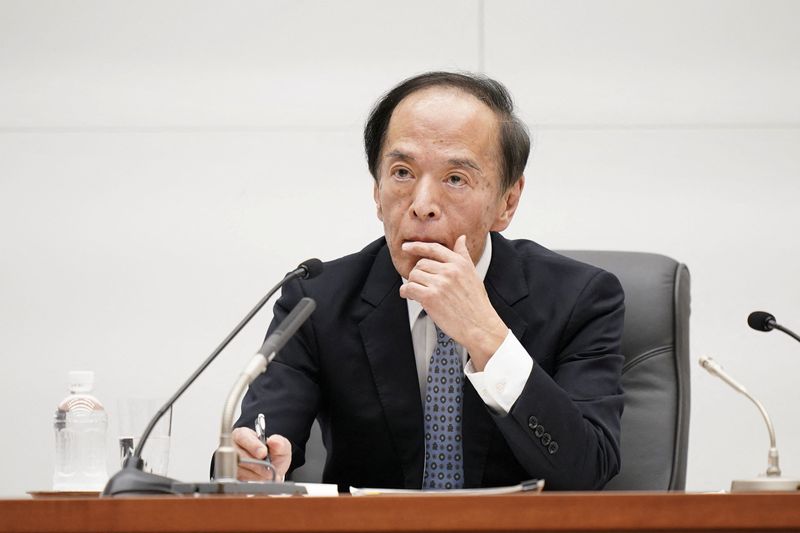By Leika Kihara
TOKYO (Reuters) -Bank of Japan Governor Kazuo Ueda will continue to dismantle the central bank's ultra-easy monetary policy settings and look to exit the decade-long accommodative regime sometime next year, an inherently risky plan that would require skilful execution.
Ultimately, however, the BOJ chief's exit strategy will require a bit of good fortune too, especially given global uncertainties including the Middle East conflict and worries about whether the U.S. economy could achieve a soft landing as well as China's growth trajectory.
Ueda's intentions are based on interviews with six sources familiar with the BOJ's thinking, including government officials with direct interaction with the bank.
Ueda will stick to a pattern he established six months in his tenure, which is to move gradually toward an exit while maintaining the dovish rhetoric of his predecessor, the sources say.
Since taking the helm in April, the central bank chief has mostly echoed his predecessor's pledge to keep monetary policy ultra-loose until sustained achievement of the BOJ's 2% price target comes into sight.
With inflation exceeding 2% for over a year, however, Ueda has steadily been phasing out the Kuroda-era stimulus starting with a removal in April of a commitment to keep rates at low levels.
Yet, Ueda will be mindful of the narrow exit path as even small hints could trigger a spike in bond yields and upend the BOJ's plan for a soft-landing.
"The BOJ's main message now is to maintain ultra-loose policy, even it seems to conflict with what it's actually doing," one source said on condition of anonymity as he was not authorised to speak publicly.
"Given uncertainty over the economic outlook, the BOJ probably wants to wait at least until spring next year in normalising policy," said another source. "If so, it makes sense to keep the BOJ's guidance dovish."
YEN RISKS
The pressure point could be the weak yen, a side-effect of ultra-low rates that has pushed up import prices and households' cost of living. If the yen continues to fall, that could heighten political pressure on the BOJ to exit sooner than it wants, some analysts say.
But knowing well the challenge of an exit based on his experience as former BOJ policymaker, Ueda will tread carefully even at the cost of causing yen falls, the sources say.
"The key is they want to leave policy easy, even if there is a cost, to leave 30 plus years of deflation behind," said Robert Samson, joint head of global multi asset at Nikko Asset Management.
"In their minds, I imagine avoiding a 'decisive end' would be preferable. Gradualism, if possible, is their preference."
But Ueda hasn't turned a blind eye to market forces. As bond yields crept up, the BOJ raised to 1% from 0.5% in July a cap set for the 10-year yield in a carefully planned tweak to yield curve control (YCC) - a policy that sets a target for the maturity around 0%.
In another step toward dismantling yield control, the BOJ relaxed its grip on long-term rates again on Tuesday by watering down 1% as a reference rather a rigid ceiling.
Having taken teeth out of YCC, the BOJ's next focus is to end its negative interest rate policy and push short-term rates to zero, from the current -0.1%, the sources say.
Exiting negative rates would be more significant than ending yield control as it means hiking a policy rate central banks have direct control over, and mark a shift to a more neutral policy stance.
'LOT OF HURDLES'
Many BOJ policymakers see the likely timing of such a move around spring next year, when there is clarity on whether annual wage negotiations may lead to strong pay hikes, the sources say.
A pivot by the BOJ, which remains a dovish outlier amid global central banks that aggressively hiked rates, could jolt markets by causing a huge repatriation of Japanese funds.
Even small signs from the BOJ of an exit could also unleash a bond sell-off that would inflict major losses on investors, and boost the cost of funding Japan's huge public debt.
"There's a lot of hurdles to clear before an exit, which means you don't want to get markets too excited about the chance of an early lift-off," a third source said.
With the cost of a spike in market rates seen as too high, the most likely scenario of an exit would be for the BOJ to end YCC and negative rates - but retain a loose pledge to intervene in the market if bond yields rise abruptly, the sources say.
Fresh BOJ estimates, which project inflation to stay well above 2% this year and next, also cast doubt on Ueda's argument that sustained achievement of his price goal was yet in sight.

The risk of sharp yen falls and an inflation overshoot may leave the BOJ with less time than it wants to exit.
"The BOJ may not afford to wait that long because the situation surrounding inflation could change sharply," said Hiromi Yamaoka, a former central bank official who worked under Ueda when he was board member. "The BOJ doesn't have much time left, a point governor Ueda is probably mindful of."